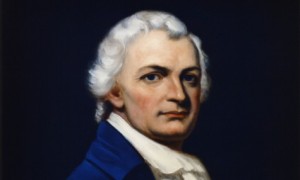 If you look at an old map of D.C., one that still has the city of Washington within its original boundaries, there is a strange notch to be seen at its northeast corner. Instead of Boundary Road (today’s Florida Avenue) continuing gracefully southeast into the Anacostia, it suddenly dips south along 15th Street before turning east along C Street NE. The land in this notch was thus part of Washington County, and not in the city of the same name.
If you look at an old map of D.C., one that still has the city of Washington within its original boundaries, there is a strange notch to be seen at its northeast corner. Instead of Boundary Road (today’s Florida Avenue) continuing gracefully southeast into the Anacostia, it suddenly dips south along 15th Street before turning east along C Street NE. The land in this notch was thus part of Washington County, and not in the city of the same name.
In this notch was, for many years, a free-flowing spring, which gave somewhere between 300 and 500 gallons of water a minute, and was thus so valuable that, so the story goes, the owner refused to allow his land to be incorporated into the new city of Washington, which would have allowed the new city to take its output and use it for the Navy Yard and Arsenal, further south.
The land was originally part of a parcel called The Grange, which had been given to one Henry Jowles in 1685, directly to the west was another patent, The Nock, which belonged to Walter Johnson. When Peter L’Enfant came along to lay out the new city, these two patents were owned by Abraham Young along with his brother William. Abraham’s house was just inside the city as laid out by L’Enfant, but he built another residence outside the city, to escape what he felt were onerous regulations he would be forced to abide by had he stayed in the new capital.
Shortly after Abraham Young died in 1797, the property was sold – but Ann Young, Abraham’s widow, refused to leave the property. Instead, she married Gerard Gibson, who had previously worked as an overseer on the property, and they continued to live on and farm it.
The spring, which was the most important feature of the property soon gained the name Gibson’s Spring, though it went under numerous other names over the years: Cool Spring, Young’s Spring, and Federal Spring. It was because of this spring that the property was used by the British under Commander Ross during the burning of Washington in 1814. He encamped his men there, and – along with a few other senior officers – fled into the house to escape the brunt of the storm that swept through the D.C. area the day after Capitol and White House had been burned. Some of Ross’s men reportedly attempted to steal some items from the Gibsons, when this was pointed out to the commander, he reprimanded them and made them return their ill-gotten booty.
And that notch? Well, that can indeed be blamed on George Washington himself. When he heard of L’Enfant’s plans, he sent a letter requesting that the spring, which Washington claimed belonged to Benjamin Stoddert, be excluded from the new city. Whether Stoddert, who had been sent to buy land surreptitiously in D.C. for use by the federal government, actually owned this land is unproven.
One thing is certain, though, this now-forgotten spring played an important role in the early years of Washington D.C. More on this next week!

